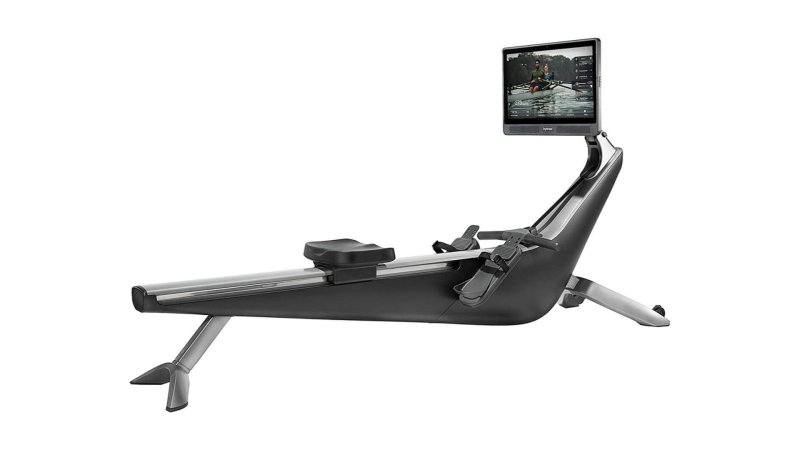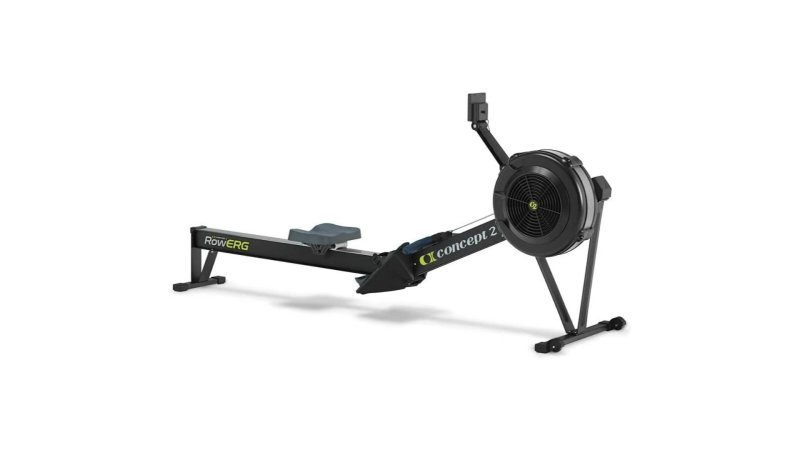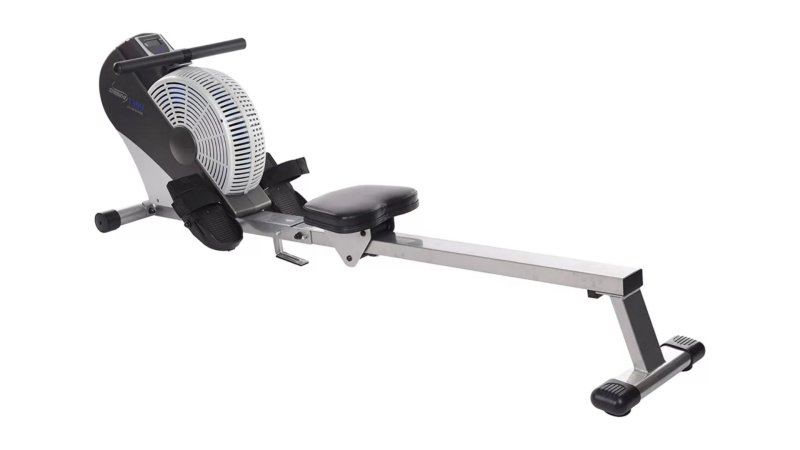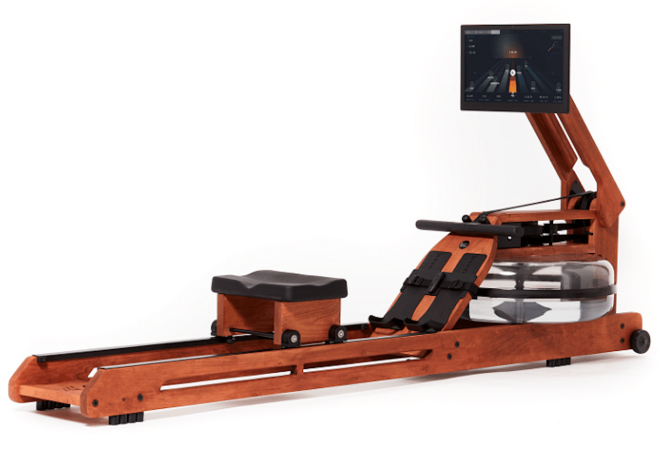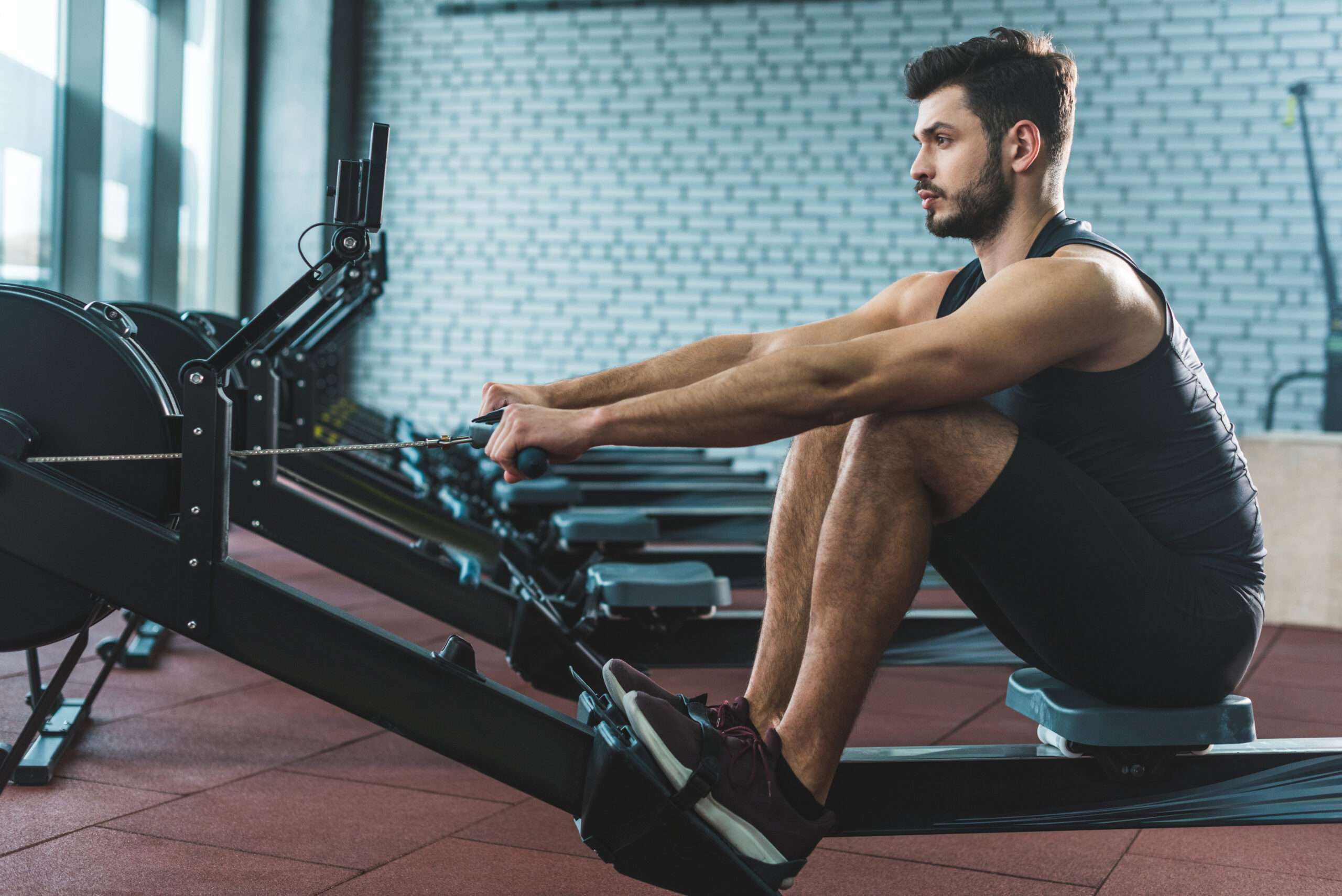

We may earn revenue from the products available on this page and participate in affiliate programs.
Love high-quality cardio, but hate running? Can’t run because of an injury or medical condition? The rowing machine might just be the right exercise solution for you.
Rowing, sometimes called “crewing,” has been around as a sport since the 17th century, when proper Englishmen competed along the River Thames. A century later, Oxford and Cambridge started rowing teams and added to the pantheon of competitive sports and events students from the two prestigious schools engaged in to prove their school’s superiority. The rower, or rowing machine, was developed as a means of replicating the movement dynamics, speed, pace, and strength necessary to be a successful rower. The rower has recently gained a great deal of popularity in America, possibly due to the increased interest in low-impact workouts and likely due to its ubiquitous presence in functional fitness gyms.
Rowing machines offer a number of benefits: They provide the user with high-quality, low-impact cardio that engages up to 86 percent of muscles when done correctly. And, most importantly, a rowing machine is not running. We analyzed the best of the available rowing machines and put together this list to help you make the best choices for your fitness and pricing needs.
Best Overall
Hydrow Rower
Pros
- Automated computer-guided resistance levels
- Accommodate users up to 6’6” tall and up to 375 pounds
- Interactive online classes, leaderboards, and races
- Very quiet operation
Cons
- Very expensive (MSRP $2295.00)
- Requires monthly paid membership to get most fitness value
- User cannot use their own music
- No, seriously, why are they so hella expensive?
Product Specs
- Weight: 145 lbs
- Resistance type: Electromagnetic storage
- Space: Floor: 86” x 25”; Upright: 33” x 25”
Best Value
Concept2 RowErg
Pros
- Compatible with most heart rate monitors
- Durability
- Easy mobility and storability
- High maximum user weight capacity
Cons
- No integrated speakers
- Basic and dated digital display
- Generates a lot of noise
Product Specs
- Weight: 57 lbs
- Resistance type: Air storage
- Space: Floor: 96” x 24” x 28”; Upright: 25” x 34” x 54”
Best Budget Pick
Stamina ATS Air Rower 1399
Pros
- Priced under $500
- Folds for easy storage
- Quick assembly
- Large footplates to accommodate any size user
Cons
- No built-in games or health monitors
- Only displays speed plus one additional metric
Product Specs
- Weight: 55 lbs
- Resistance type: Air
- Size: Floor: 77” x 18” x 22”; Folded: 48” x 18” x 28”
Best High-Tech Rowing Machine
Ergatta Rower
Pros
- Handmade in Rhode Island from American cherry wood
- Customized workouts and real-time remote interactive races with other Ergatta users
- 17.3” high-definition touch screen display
- Can accommodate a user up to 6’8” and 500 pounds
Cons
- Expensive (MSRP $2199.00)
- Loud when in use
- No instructors; very reliant on competition with online Ergatta community
Product Specs
- Weight: 103 lbs with water; 76.5 lbs without water
- Resistance type: Water
- Size: Floor: 86” x 23” x 40”; Upright 86” x 23” x 22.5”
Best Rowing Machine for Beginners
Sunny Health u0026 Fitness SF-RW5515
Pros
- Inexpensive (MSRP $249 – $399)
- Quiet operation
- Display shows time elapsed, stroke count, and calorie count
- Foldable for easy storage
Cons
- Display does not show intensity or speed
- Footplates are not adjustable
- No BlueTooth connectivity
- No workout tracking, classes, or games
Product Specs
- Weight: 59 lbs
- Resistance type: Magnetic
- Size: Floor: 82” x 19” x 23”
Why you should trust us
I have used rowing machines for many years as a cross-training tool, which became more relevant in recent months when a leg injury sidelined me from running. As a gear reviewer for Task & Purpose, I’ve conducted comprehensive reviews of a variety of items from hiking shoes to throwing axes. For this particular article, I compiled data from multiple sources and used my own experience with rowing machines to put together a comprehensive guide you can use to make the choices that suit your training, fitness, and budgetary needs.
Types of rowing machines
The type of rowing machine typically refers to how that category of rower provides resistance. The four types are air, water, magnetic, and hydraulic. Each has its own pros and cons, but the ultimate choice should be based on your individual needs.
Air
Air rowers work by creating resistance from an internal flywheel located in the front of the rower. The rower’s pull chain is attached to the flywheel and the harder and faster you pull, you generate more resistance, and the difficulty increases. The air rower is the most popular resistance type and most commonly found. The Concept 2 rower uses air resistance.
Air rowers tend to stow away easily, but they are generally one of the noisier styles of rowing machines.
Water
Water rowers use a flywheel system, but the flywheel is encased in a water tank. Like the air rower, the flywheel generates resistance against the water, and that resistance increases your workload. Water rowers are commonly built of high-quality wood, giving the water rower an elegant, almost furniture-like appearance. This can offset their larger size and limited ability for stowing away. Frank Underwood used a water rower in Game of Thrones.
Many experts agree the water rower has a smoother pull that better replicates open water. The strokes from a water rower are usually more consistent than with an air rower. Water rowers are quieter than air rowers, but not silent. The whooshing sound of water can be hypnotic and relaxing. The Ergatta Rower is a water rower.
Magnetic
Magnetic rowers use a flywheel which has a series of powerful magnets that are set at varying distances from the flywheel to increase or decrease resistance. The magnetic rowers are the most silent of the rowers, which makes them highly suitable for apartments and condominiums. Resistance is adjusted manually, not with the increased or decreased effort of the user.
Hydraulic
The hydraulic rower uses (spoiler alert!) hydraulic pistons to create resistance. The pistons are set to a specific resistance at the start of the workout. Like the magnetic rowers, hydraulic rowers don’t rely on the effort of the user to create drag. The pistons, however, can heat up significantly during a workout, causing the resistance to lower slightly as the heated mechanisms find less drag. Hydraulic rowers are typically the least expensive style of rowers.
Key features of rowing machines
Flywheel
The flywheel is the part of the rowing machine that creates the resistance using water, air, magnetics, or hydraulics. It is the large round wheel at the front of the rowing machine. These vary in how they create resistance and how much noise they generate — air and water being the loudest and magnetic being the quietest. Magnetic flywheels work by having magnets that can be adjusted closer or farther from the flywheel to increase and decrease resistance. With water and air resistance, the resistance is largely based on how hard and fast the user pulls the cable.
Damper
The damper is the instrument on the side of the flywheel of an air resistance rowing machine. The damper controls the amount of airflow to increase or lower the resistance. Many competitive rowers set their dampers to the lower settings to more effectively mimic the resistance encountered by water, versus the higher levels of resistance which provide a tougher workout but don’t mimic the water feel.
Footplate
The footplates are, like they sound, the place where you place your feet, like pedals on a bicycle or stationary bike, but with less movement. Footplates have different sizes and levels of adjustability depending on the model of rowing machine. The placement and function of the footplates can affect how well a rowing machine functions for different-sized users. The footplates also strap in your feet for increased stability during a workout.
Rail
Simply stated, the rail is the spine of the rowing machine on which the seat slides forward and backward. They are usually made of steel or aluminum. Some of the more well-designed rowers will take steps to ensure the seat slides along the rail as smoothly as possible.
Seat and seat rollers
This is self-explanatory. The seat is the thing you sit on and can be made of hard contoured plastic or padded materials. The seat rollers are the wheels that the seat rolls on as it travels up and down the rail of the rowing machine.
Handle
The handle is a horizontal bar at the front of the rowing machine which is connected to a chain or strap. Pulling the handle engages the chain or strap and creates tension throughout the movement. The user is cautioned not to release the handle without guiding it back to the start position because the handle can snap back and damage the rower or the rower’s display. Handles are made from a variety of materials and some are more contoured than others.
Display
The display is the screen or monitor at the front of the rower that allows the user to track time and progress. The display can range from very minimal text-based displays to large and elaborate touchscreen HD monitors that rival the nicest televisions and computer monitors. Some models also allow the user to provide a tablet as the display. Displays provide the user with a variety of metrics and measurements including speed, time elapsed, pace, distance, calories, and heart rate. Some displays are capable of playing videos, classes, instruction, and leaderboards. Others have speakers and/or BlueTooth compatibility.
Benefits of rowing machines
Low impact cardio
The most obvious benefit of using rowing machines is the ability to get exceptional cardio and engage in HIIT (High-Intensity Interval Training) without the high impact associated with running outdoors or on a treadmill.
Space management
Rowing machines are typically long, but thin. Some fold for storage and several are designed to be stood up on end for better space management. Unlike a treadmill, elliptical, or stationary bike, most rowing machines are comparably light and designed to be stored out of the way. This makes them a very beneficial fitness tool if you have limited space, such as an apartment or condominium.
Full body workout
A 2008 study found those using proper form and technique with rowing machines can engage up to 86 percent of the body’s muscles. The American Fitness Professionals Association assesses a properly executed rowing stroke as composed of 65 to 75 percent leg work and 25 to 35 percent upper body engagement.
Better sex
This one is mostly just an attention grabber, but cycling and stationary biking both increase a man’s chances of erectile dysfunction, genital numbness, and infertility. Your faithful rowing machine, however, will provide you with indoor cardio opportunities and never challenge your manhood.
Pricing considerations for rowing machines
Pricing considerations for rowing machines run the gamut from a couple of hundred dollars to over two thousand dollars. As a purchaser, you have to decide what you need and don’t need along with what your budget will support. A beginner can get by with a much lower-priced rowing machine, whereas a professional athlete or more experienced user may need something more expensive.
The pricing of rowing machines can be looked at in three basic categories:
- Value: Up to $750.
- Mid-Range: $750 to $2,000.
- Premium: $2,000 and up.
Think of rowing machines in the different pricing categories as you would think of cars. They’re all going to accomplish the basic task you need them for, but some are going to make the ride a little more fun. And you, the buyer, need to be cautious to balance your needs, desires, and budget.
Value
Your value rowers will serve you very well, but without all the frills, bells, and whistles. You’re going to get a quality rowing machine that does what you need it to do: get you in shape. With a value rower, you can expect to have limited display options and very basic connectivity. With these rowers, you may want to throw in your wireless earbuds and kick in your favorite cardio playlist from your personal music catalog or streaming music service. These are great rowers to jump in with and see if you really plan to make rowing a part of your fitness routine, or if your rower is going to sit in the corner under a pile of laundry.
Mid-range
Mid-range rowing machines bring a little bit of everything. They run a wide range from very basic amenities to very high-end electronics. With the mid-range rowers, you are going to find in many cases a more refined functionality in your rower, e.g. smoother pulls with more consistent resistance and better interconnectivity with wireless devices such as heart rate monitors. With the mid-range rowers, you will find better accessories for tracking workouts, progress, and goals.
Premium
A premium rower is everything you expect it to be. You get the highest performing machines and they come with the most advanced electronics and connectivity. These are the only ones on the list worthy of being called luxurious. With premium rowers, you have access to personalized training plans and high-definition video instruction. Many even include interactive views of famous bodies of water you can pretend to be rowing in as you work out.
How we chose our top picks
There is no shortage of reviews of rowing machines. While I would have loved to physically test each rowing machine mentioned in this article, my editor laughed for close to 45 minutes when I submitted a voucher for almost a dozen rowing machines. Instead, I did the next best thing and read a couple of dozen articles written by people who already did the work.
When I began looking at rowers, I focused on a handful of specific metrics: functionality, connectivity, display, and structural design. How well does a particular rower do its very basic job of providing a means for a quality workout? Will the rower connect to your heart rate monitor or smartwatch, or an app or online program to track your goals and progress? Does it have a clean design? Is it elegant or utilitarian? Is the rower best suited to be in your family room or your garage gym? How much weight can the rowing machine handle?
Much like purchasing a vehicle, a boat, or a bicycle, the buyer is well-served by all the pertinent variables prior to swiping your debit card. I compiled all of this data into an exceptional piece of journalistic excellence to help you make your choice.
FAQs on rowing machines
You’ve got questions, Task & Purpose has answers.
Q: How do I use a rowing machine?
A: The most important thing when using a rowing machine is to maintain proper posture and technique to avoid injury. The rowing machine workout is low-impact, but you are using a very high percentage — up to 85 percent — of your muscles. Like lifting weights, there is a time for pushing with your legs and a time for using your upper body.
As I am not a certified personal trainer, I will defer to those who have the expertise and recommend you seek out the assistance of a personal trainer or use a video instructional guide for step-by-step learning of proper technique.
Q: How long should you row on a rowing machine?
A: The answer to this is predicated on your individual fitness goals. Aerobic exercises can go anywhere from 45 to 90 minutes, whereas an anaerobic workout like a HIIT (High-Intensity Interval Training) workout could go from 5 to 20 minutes duration.
Q: Is a rowing machine safe for pregnancy?
A: Rowing machines are an excellent choice for cardio workouts during pregnancies. Rowing machine workouts are low-impact and do not have the same balance considerations as treadmills and ellipticals. As with any physical activity during pregnancy, you should consult with a medical professional before undergoing a new fitness program.
Our gear section
Paul O’Leary is an Army veteran and tactical nerd. He’s served multiple tours in Atropia and other theaters and once ate a Norwegian reindeer MRE. He fancies himself a connoisseur of good bourbon, wine, and cigars. He also writes for Duffel Blog. Follow him on Twitter at @pauljoleary.
